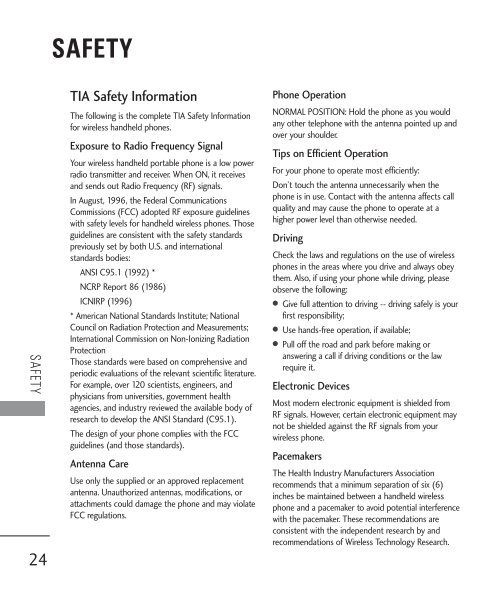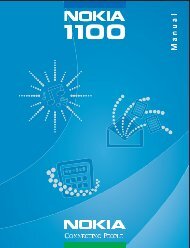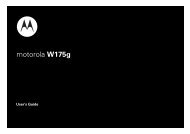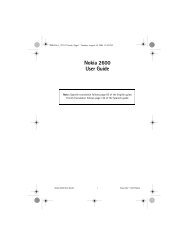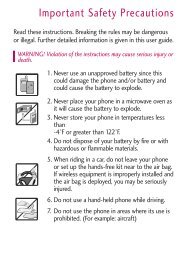You also want an ePaper? Increase the reach of your titles
YUMPU automatically turns print PDFs into web optimized ePapers that Google loves.
SAFETY<br />
24<br />
SAFETY<br />
TIA Safety Information<br />
The following is the complete TIA Safety Information<br />
for wireless handheld phones.<br />
Exposure to Radio Frequency Signal<br />
Your wireless handheld portable phone is a low power<br />
radio transmitter and receiver. When ON, it receives<br />
and sends out Radio Frequency (RF) signals.<br />
In August, 1996, the Federal Communications<br />
Commissions (FCC) adopted RF exposure guidelines<br />
with safety levels for handheld wireless phones. Those<br />
guidelines are consistent with the safety standards<br />
previously set by both U.S. and international<br />
standards bodies:<br />
ANSI C95.1 (1992) *<br />
NCRP Report 86 (1986)<br />
ICNIRP (1996)<br />
* American National Standards Institute; National<br />
Council on Radiation Protection and Measurements;<br />
International Commission on Non-Ionizing Radiation<br />
Protection<br />
Those standards were based on comprehensive and<br />
periodic evaluations of the relevant scientific literature.<br />
For example, over 120 scientists, engineers, and<br />
physicians from universities, government health<br />
agencies, and industry reviewed the available body of<br />
research to develop the ANSI Standard (C95.1).<br />
The design of your phone complies with the FCC<br />
guidelines (and those standards).<br />
Antenna Care<br />
Use only the supplied or an approved replacement<br />
antenna. Unauthorized antennas, modifications, or<br />
attachments could damage the phone and may violate<br />
FCC regulations.<br />
Phone Operation<br />
NORMAL POSITION: Hold the phone as you would<br />
any other telephone with the antenna pointed up and<br />
over your shoulder.<br />
Tips on Efficient Operation<br />
For your phone to operate most efficiently:<br />
Don’t touch the antenna unnecessarily when the<br />
phone is in use. Contact with the antenna affects call<br />
quality and may cause the phone to operate at a<br />
higher power level than otherwise needed.<br />
Driving<br />
Check the laws and regulations on the use of wireless<br />
phones in the areas where you drive and always obey<br />
them. Also, if using your phone while driving, please<br />
observe the following:<br />
● Give full attention to driving -- driving safely is your<br />
first responsibility;<br />
● Use hands-free operation, if available;<br />
● Pull off the road and park before making or<br />
answering a call if driving conditions or the law<br />
require it.<br />
Electronic Devices<br />
Most modern electronic equipment is shielded from<br />
RF signals. However, certain electronic equipment may<br />
not be shielded against the RF signals from your<br />
wireless phone.<br />
Pacemakers<br />
The Health Industry Manufacturers Association<br />
recommends that a minimum separation of six (6)<br />
inches be maintained between a handheld wireless<br />
phone and a pacemaker to avoid potential interference<br />
with the pacemaker. These recommendations are<br />
consistent with the independent research by and<br />
recommendations of Wireless Technology Research.


